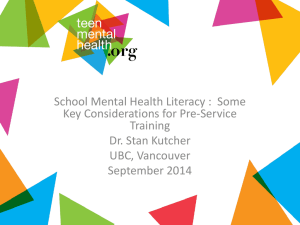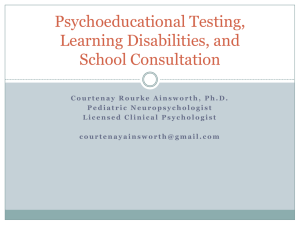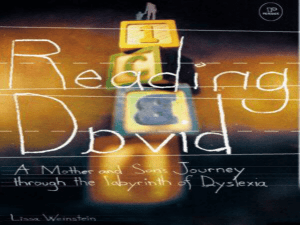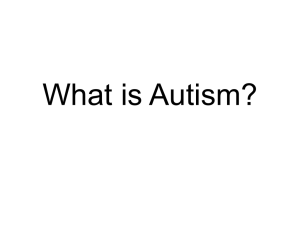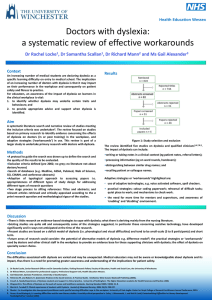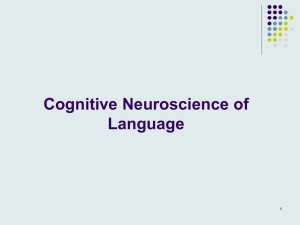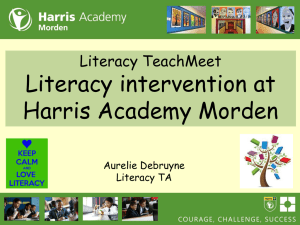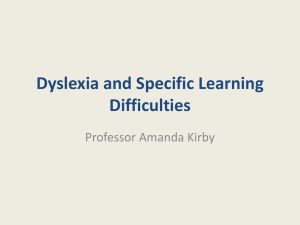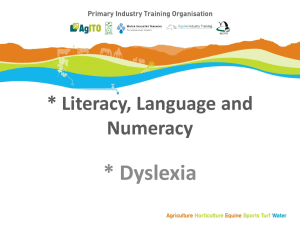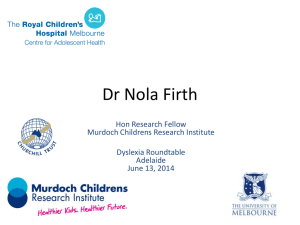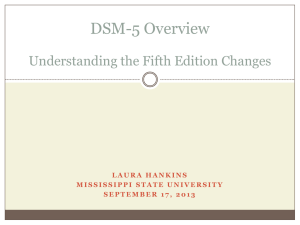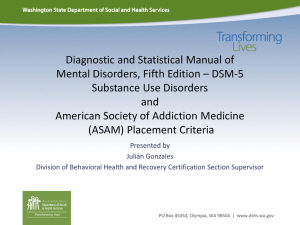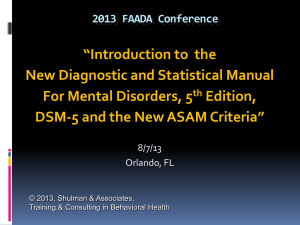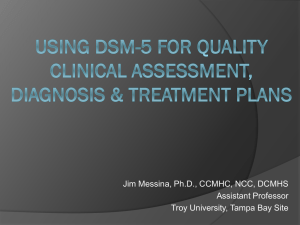Advances in Reading Assessment and
advertisement
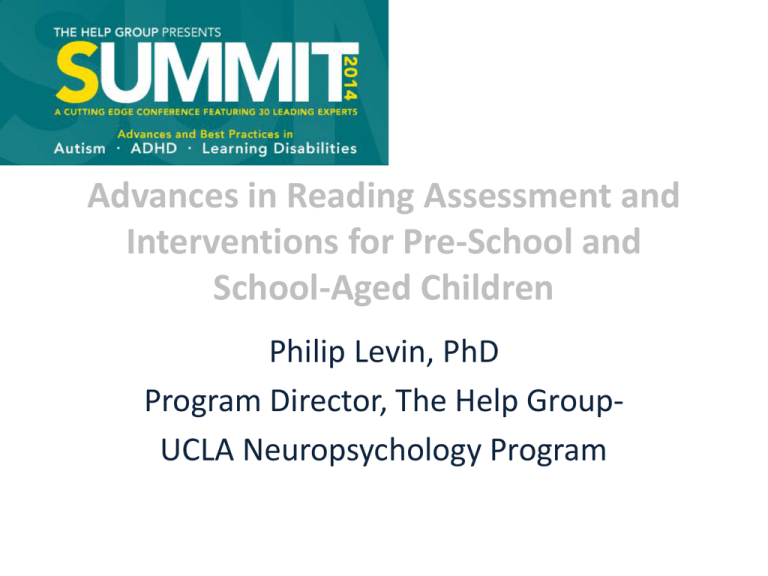
Advances in Reading Assessment and Interventions for Pre-School and School-Aged Children Philip Levin, PhD Program Director, The Help GroupUCLA Neuropsychology Program Advances in Three Domains • Causation Research • Diagnosis • Assessment TOPIC # 1 ADVANCES IN CAUSATION RESEARCH Galaburta, 1994 3 neural pathways for reading Parieto-Temporal Word Analysis Mental Images of Letters Recognition of words Broca’s Area analysis of speech sounds & phonotactic frequency Occipital Temporal Instant Word Recognition Reliance on ancillary systems Word Form Area Fails to form Remediation compensates for accuracy not automaticity An overreliances on certain areas of the brain leads to inaccurate and/or slow, effortful reading that typically originates with weaknesses in the phonological processing system of language – Shaywitz, 1992 Non -impaired brain while reading Child with reading disability While reading Geshwind, 2003 Galaburta, 2012 We know that most people with Reading Disorders have structural differences in the brain that differs from those who do not have difficulties with the acquisition of reading • BUT • We don’t know what causes the structural differences • We don’t know if the structural differences are the cause or the effect of poor decoding abilities • We don’t know why all people with structural differences do not develop reading disorders Causes of Structural Differences Genetic • Anecdotal Data Environmental • Literacy Rich Environment • Genetic Data – FOXP2 gene that, when disrupted, causes a complex speech and language disorder and structural brain differences (Lai, Fisher, Hurst,, 2001) – GNPTAB gene that is causal in expressive delays including stuttering (Kang et al., 2010) • Quality of Instruction Language Rich Environments • Exposure to varied vocabulary. – Knowing the “right word” is vital if one is to communicate information clearly. Large vocabularies have long been known to be linked to reading success (e.g., Anderson & Freebody 1981 • Opportunities to be part of conversations that use extended discourse. – Extended discourse is talk that requires participants to develop understandings beyond the here and now and that requires the use of several sentences to build a linguistic structure, such as in explanations, narratives, or pretend talk. • Home and classroom environments that are cognitively and linguistically stimulating. – Children are most likely to experience conversations that include comprehensible and interesting extended discourse and are rich with vocabulary when their parents are able to obtain and read good books and when their teachers provide classrooms with a curriculum that is varied and stimulating. Literacy Rich Environments • Most children enter K with knowledge of typical 8,500 most common words in the English language • Exposure to less common, more sophisticated vocabulary at home relates directly to children’s vocabulary acquisition. • Good readers combine a variety of strategies to read words. • Children who acquire strong vocabularies increase their ability to make sense of what a word might be while using what they know about phonics. • Language- poor families are likely to use fewer different words in their everyday conversations – The language environment is more likely to be controlling and punitive. Literacy Rich Environments • Relationship Between Home Literacy Environment and Reading Achievement in Children with Reading Disabilities - Fontina L. Rashid (2005) – Parents' home literacy activities were significantly related to children's passage comprehension and spelling scores • Home Literacy Environment and Its Role in the Achievement of Preschoolers With Disabilities - Elaine Carlson (2010) – Home literacy environment of 3- to 5-year-olds was a significant predictor of scores on a test of receptive vocabulary and reading comprehension in later years. • Maternal literacy practices and toddlers’ emergent literacy skills - Claire Maples Edwards (2014) – Mothers engaged in several emergent literacy behaviors with their toddlers during sharedreading interactions. Some of these behaviors were also exhibited by their children. The behaviors observed in mothers and toddlers were related to the written language awareness domain Quality of Instruction • A 2011 federal study analyzing the effectiveness of four widely used direct instruction reading programs – – – – • • Spell Read P.A.T. Corrective Reading Wilson Reading Failure Free Reading After one year of instruction, there were significant impacts on phonemic decoding, word reading accuracy and fluency, and comprehension Reading skills can only be significantly improved through direct instruction in word-level skills The Five Pillars of Direct Reading Instruction Phonemic Awareness Training Noticing the sounds of spoken language Phonemic Instruction Teaching letter-sound relationships (grapheme/phoneme) Fluency Instruction Reading text accurately and quickly Vocabulary Instruction Instruction in the words necessary for effective communication Comprehension Instruction The ability to understand meaning from what is read. Quality of 1:1 reading instruction 90% 80% 70% 60% Students taught in small groups of 2-6 students were able to make the same gains in reading performance as students taught in one-on-one sessions. 50% Pre 40% 30% 20% Post Certified teachers and reliably trained adult volunteers were equally able to help struggling readers in both one-on-one and small group settings. 10% 0% 1:1 reading with a specialist 1:1 reading with a paraprofessional 1:6 reading with a specialist 1:6 reading with a paraprofessional Conclusions • Dyslexia is a specific learning disability that is neurological in origin – It is characterized by difficulties with accurate and / or fluent word recognition and by poor spelling and decoding abilities. – These difficulties typically result from a deficit in the phonological component of language – It is unexpected in relation to other cognitive abilities and the provision of effective classroom instruction • A significant proportion of reading disordered students suffer from additional auditory, visual or motor disorders. • There is a genetic underpinning to Dyslexia • However, genetics alone cannot explain reading differences DIAGNOSTIC ADVANCES Changes in Diagnosis DSM-IV • Reading Disorder, Math Disorder , Disorder of Written Expression, and LDNOS DSM-5 • Specific Learning Disorder • Neurodevelopmental Section • impedes the ability to learn or use specific academic skills (e.g., reading, writing, or arithmetic), which are the foundation for other academic learning • Learning difficulties are ‘unexpected’ in that other aspects of development seem to be fine Changes in Diagnosis DSM-IV DSM-5 • • • • Criteria A - one of six symptoms of learning difficulties that have persisted for at least 6 months despite the provision of extra help or targeted instruction Criteria B - (the affected academic skills are substantially and quantifiably below those expected for age and cause impairment in academic, occupational, or everyday activities, as confirmed by individually administered standardized achievement measures and comprehensive clinical assessment Criteria C - during the school-age years, although may not fully manifest until young adulthood in some individuals Criteria D - Intellectual Disabilities, uncorrected auditory or visual acuity problems, other mental or neurological disorders) or adverse conditions (psychosocial adversity, lack of proficiency in the language of instruction, inadequate instruction) must be ruled out before a diagnosis of SLD can be confirmed. Summary Changes • Go from 3 diagnoses to 1 overarching diagnosis • Abandonment of the IQ-Achievement Discrepancy • Psychometric data alone are insufficient for a DSM-5 diagnosis of SLD – Requires evidence of symptom persistence – Quantify low academic achievement from multiple sources • formal and informal school records • academic portfolios • instructional history Diagnostic Concerns • ASHA expressed concern about the omission of oral language as a diagnostic criterion for specific learning disorder DSM-5 • ASHA preferred the term specific learning disability, well-established clinical and research term, rather than specific learning disorder. – Disability addresses the impact of a disorder and represents a lifelong problem. Diagnostic Concerns • Shaywitz (2013) supports – (1) Dyslexia, where much is known scientifically and clinically, and the criteria are based on science; – (2) the less well-defined Other Learning Disorders where the pathophysiology, neurobiology and mechanisms, which are less well understood, find a home. • Harming and discriminating against patients by denying a diagnosis to individuals with dyslexia and related learning disorders who are bright, demonstrate an unexpected difficulty in reading and read slowly with great effort – While dyslexia may significantly and negatively impact the affected individual, at the same time, there may be no or little noticeable negative impact on academics or occupational performance • Overlooking the needs of older children and adults by limiting the criteria to school age children, and, thus, limiting the diagnosis only to young children – By requiring “current” measurement of skills, overlooking the persistence of both dyslexia and the associated lack of fluency and word retrieval difficulties dx • 1969, a formal definition of reading failure was put forward by Critchley3 with a neurobiological etiology in mind: "Specific Developmental Dyslexia: A disorder manifest by difficulty in learning to read despite conventional instruction, adequate intelligence, and socio-cultural opportunity. It is dependant upon fundamental cognitive disabilities which are frequently of constitutional origin". • dyslexia as an unexpected reading problem that occurs despite normal intelligence, and that is often accompanied by a family history of similar reading, spelling or language problems • Developmental dyslexia is traditionally defined as a discrepancy between reading ability and • intelligence in children receiving adequate reading tuition DX • Barbara Foorman from the University of Texas, Houston Medical School, "88 percent of students who were poor readers in first grade were poor readers in fourth grade" (National Institute of Child Health and Human Development [NICHD], 2000, 9). • For the special education population excluding SLD, • the evidence of service rate increased from diagnostic criteria do not depend upon 94% to 95% from 2008-09 to 2009-10 whereas comparisons with overall IQ and are consistent in the USA’s the reauthorized IDEA regulations (2004) which state that: • SLD only rate increased from 91% to 93 “the criteria adopted by the State must not require the use of a severe discrepancy between intellectual disability and achievement for determining whether a child has a specific learning disability, as defined in 34 CFR 300.8 (c)(10).” (APA, 2012 ADVANCES IN ASSESSMENT Assessment scores • 4 levels of interpretation • Qualitative – weighted sums • Level of Development – age equivalents • Level of proficiency – RPI – 20/20 vision vs 20/200snellen index • Relative standing in a group – norm referenced data • • • • Age/Grade Equivalents Percentile Rankings Standard Score RPI – criterion rated reference score • This means that psychologists may be able to shift from ‘assessment for diagnosis’ to ‘assessment for intervention’ and have more time to provide psychoeducation and consultation with parents and teachers. RPI - vision corollary RPI • 90/90 – – level of proficiency on tasks that typical age- or gradepeers would perform with 90% proficiency – 55/90 on the Letter-Word Identification subtest would indicate that on similar tasks, the student would demonstrate 55% profiencieny, whereas age- or gradepeers would demonstrate 90% accurac • Independent Level = RPI 96/90 or above (EASY) • Instructional Level = RPI 95/90 to 76/90 • Frustration Level = RPI 75/90 or below (DIFFICULT)




